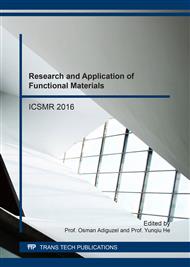p.89
p.93
p.101
p.105
p.110
p.116
p.121
p.127
p.133
Machinability Analysis in Drilling Glass/Epoxy Composites with Filled MWCNTS
Abstract:
Drilling is the most used machining process in the assemble of Glass/epoxy composites. Material removing leads to damage and delamination in the drilling process. The present paper deals the effect of drill wt.% of multi walled carbon nanotubes (MWCNTs) on the drilling of glass/epoxy composites in term of torque and push-out delamination. Glass/epoxy composites manufactured by using pre-preg method. The filled rates were considered as 0.5, 1 and 2 wt.%. MWCNTs. Also, the unfilled composite samples were used for comparison. Various cutting speeds (40, 50 and 60 m/min) and feed rates (0.075, 0.1 and 0,125 mm/rev) for coated drills were used. The experimental result showed that the machinability properties of glass/epoxy composites samples can be improved with filling MWCNTs. Higher cutting speed and feed rate increase delamination. Push-out more severe than that of peel-up delamination.
Info:
Periodical:
Pages:
110-115
Citation:
Online since:
July 2017
Authors:
Price:
Сopyright:
© 2017 Trans Tech Publications Ltd. All Rights Reserved
Share:
Citation:


